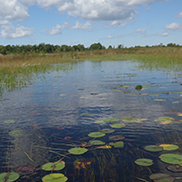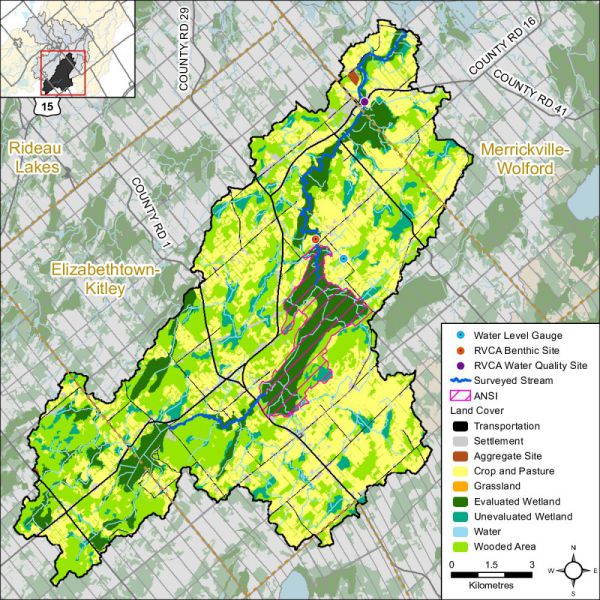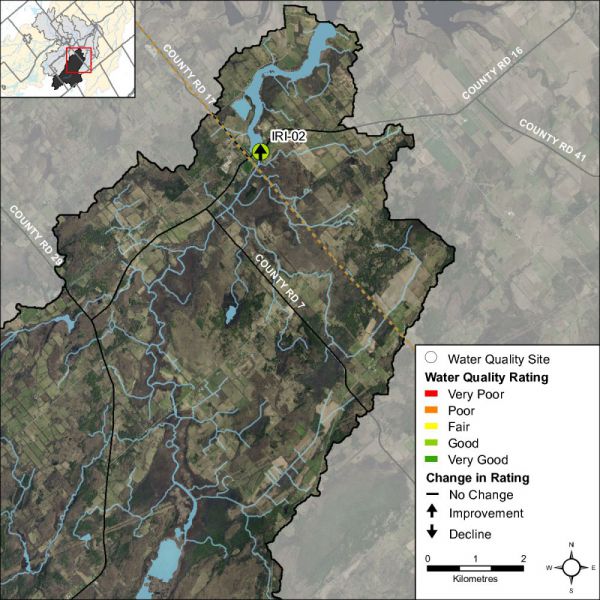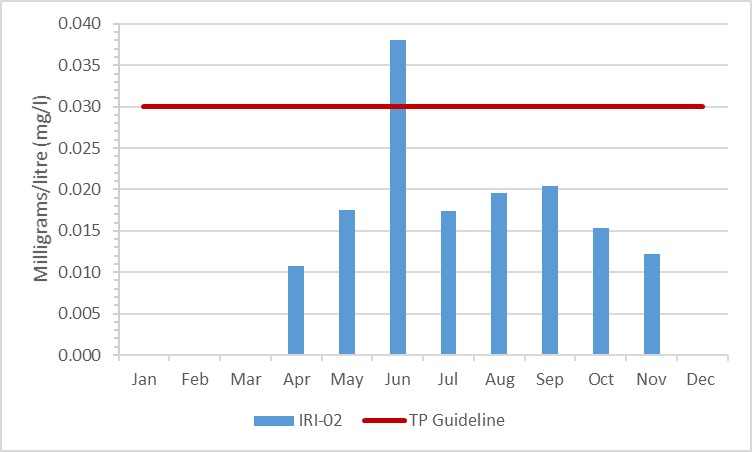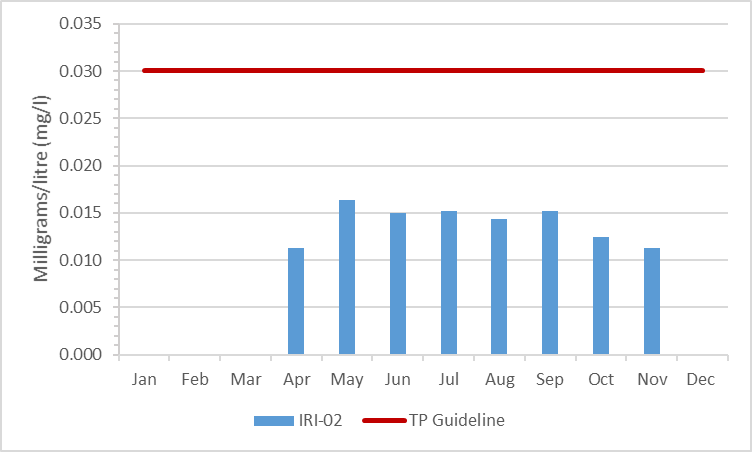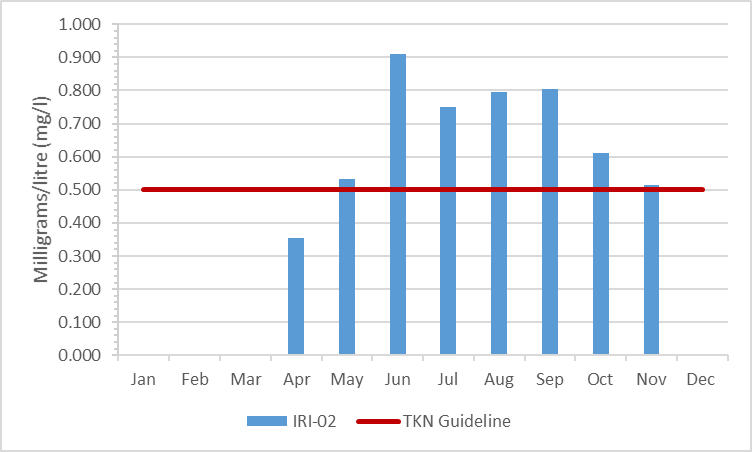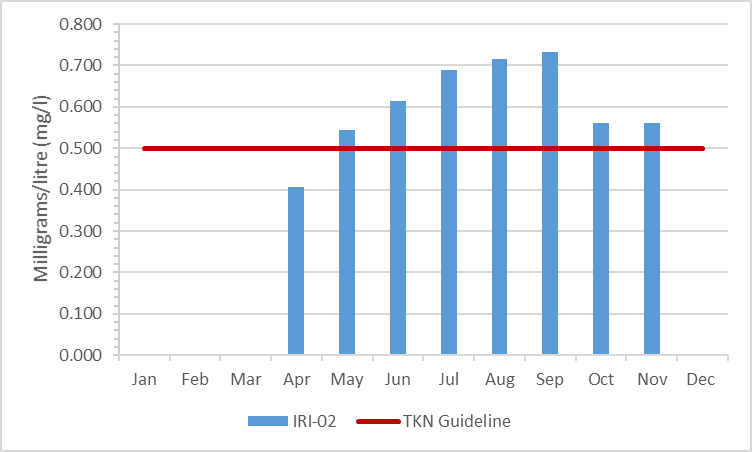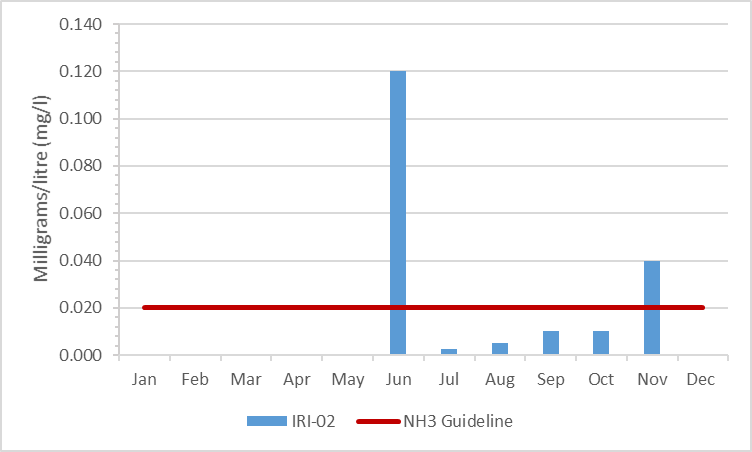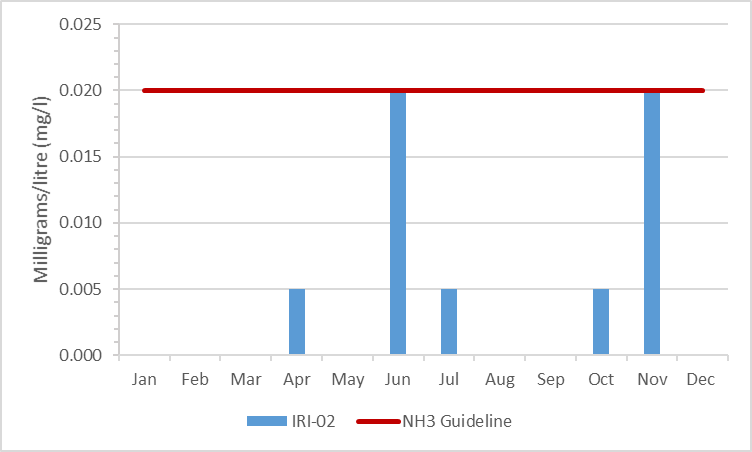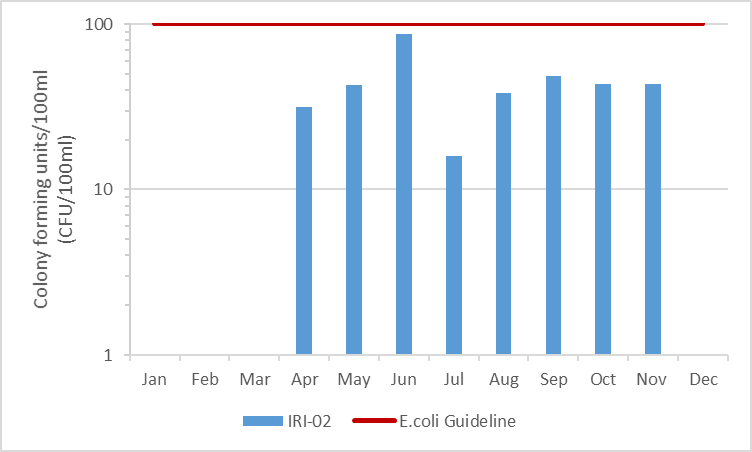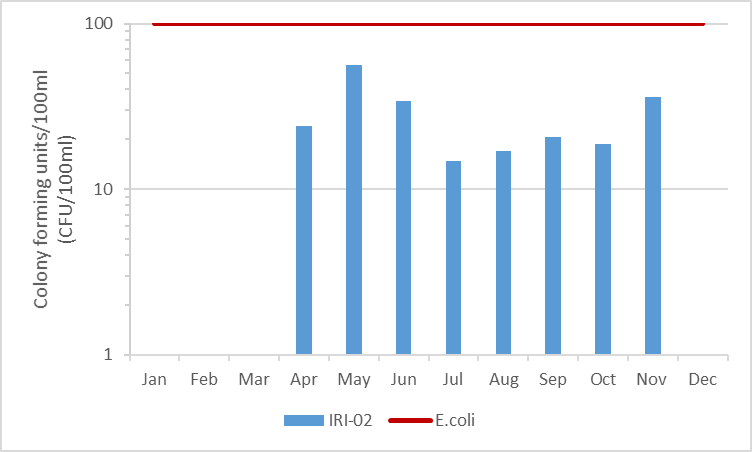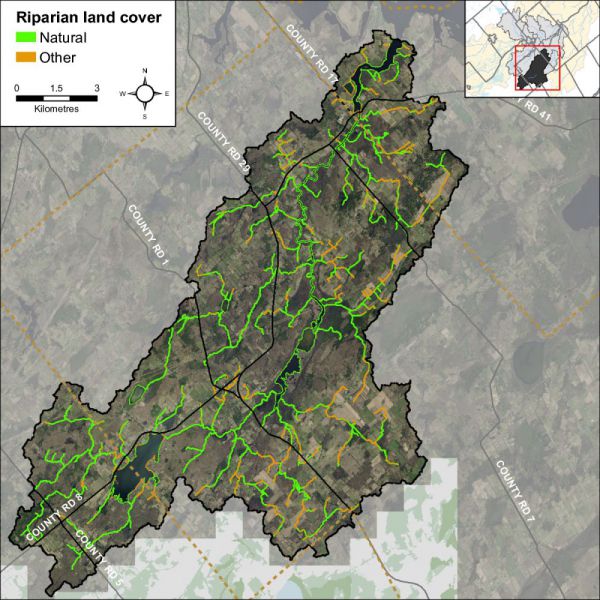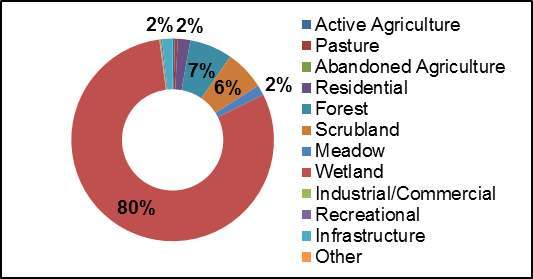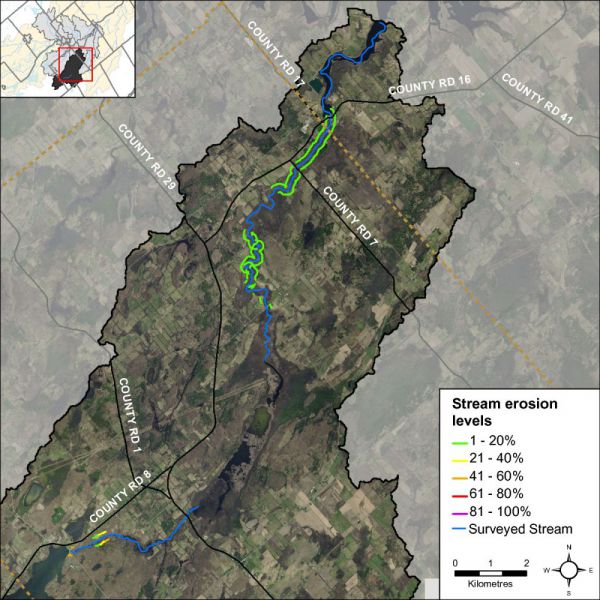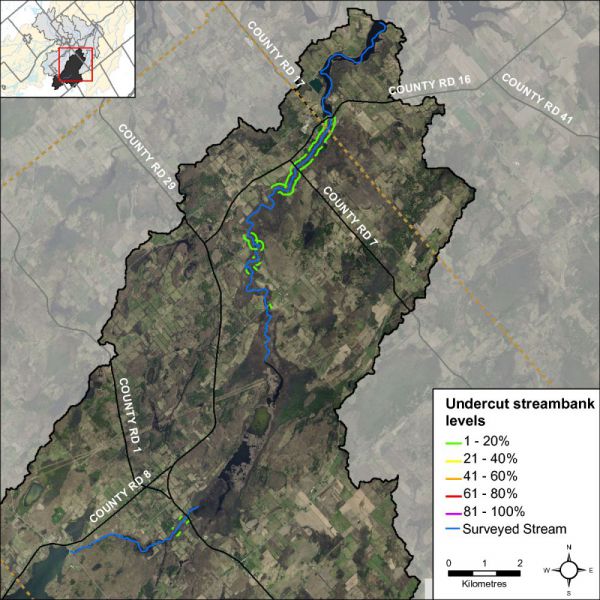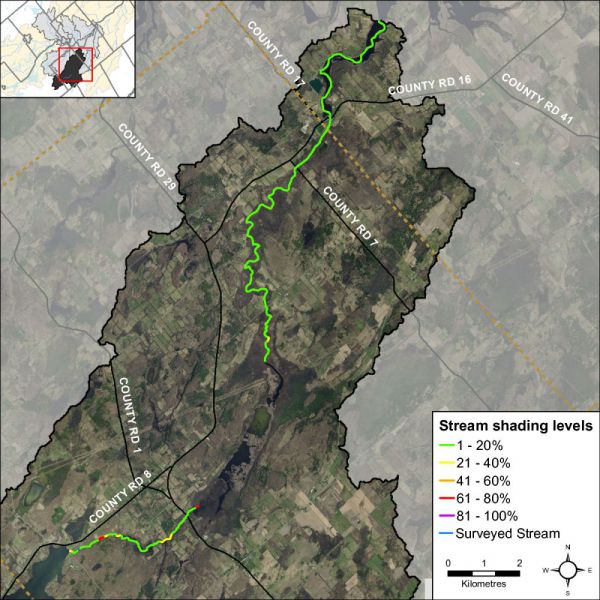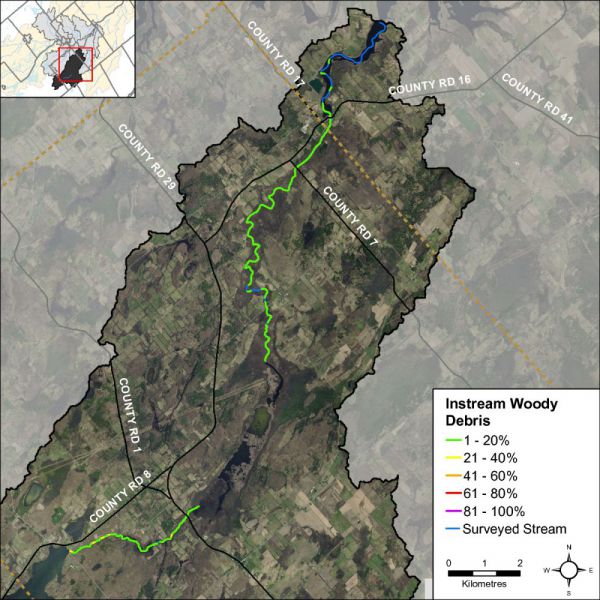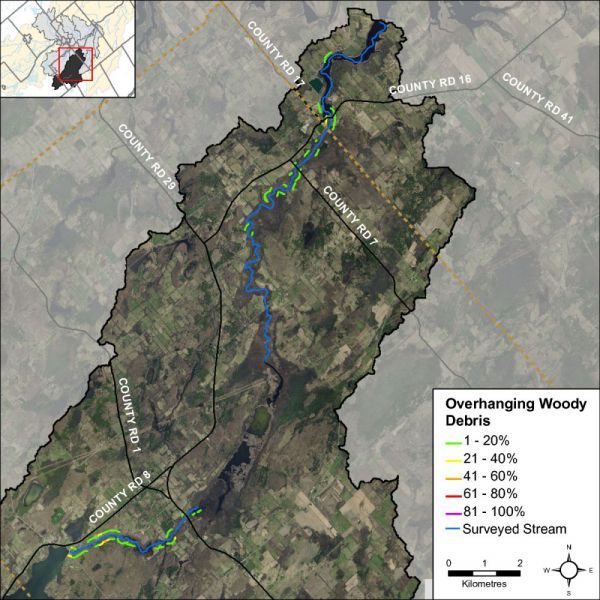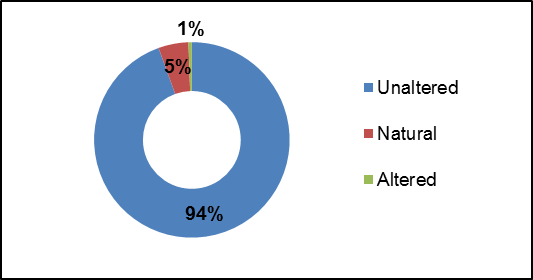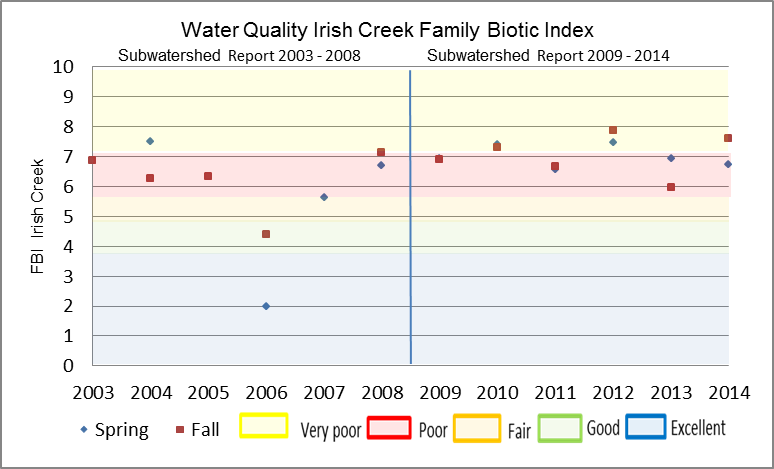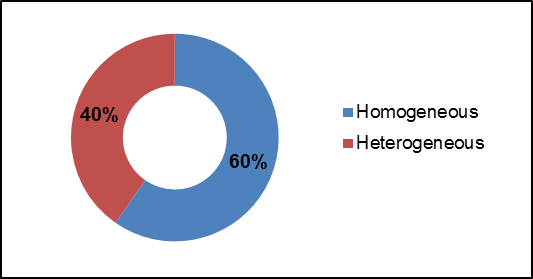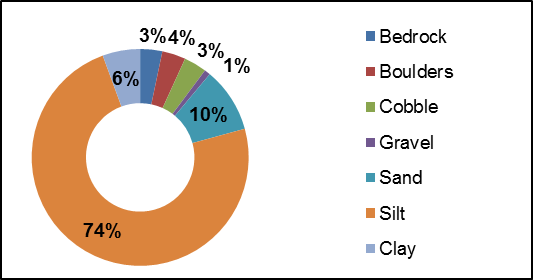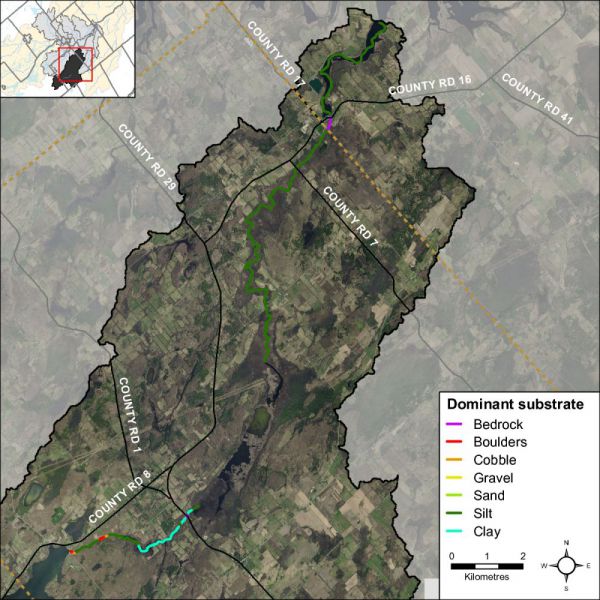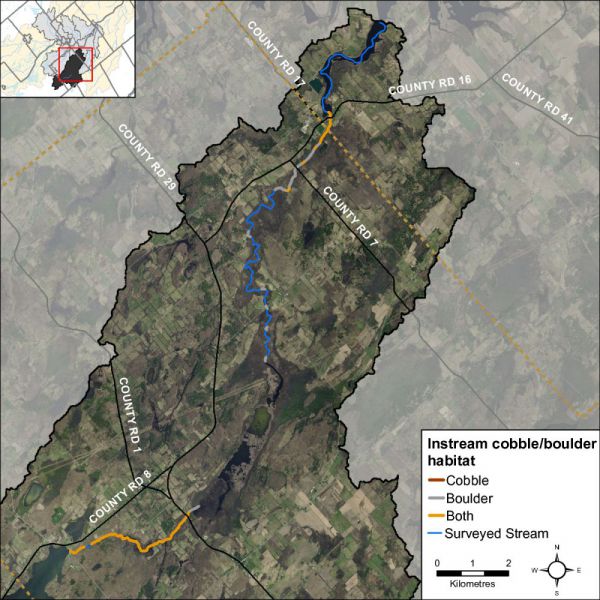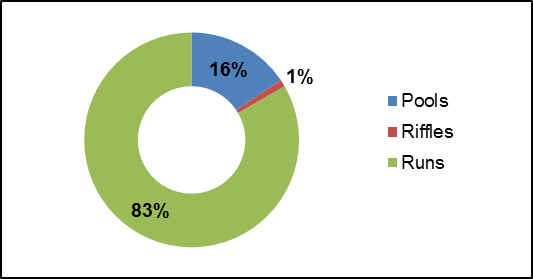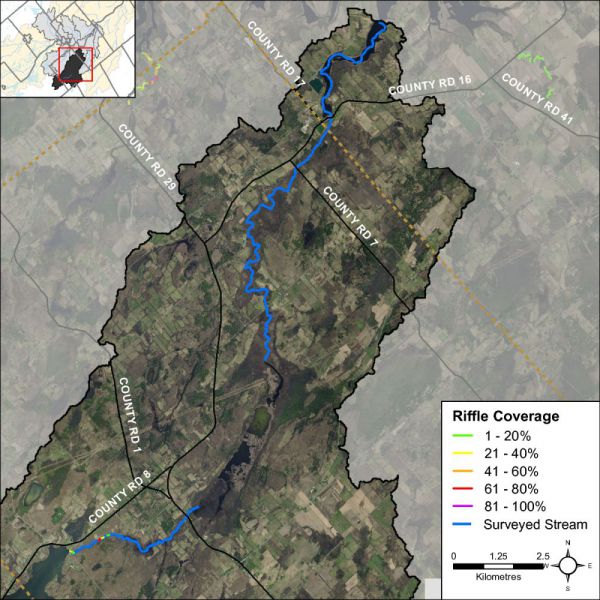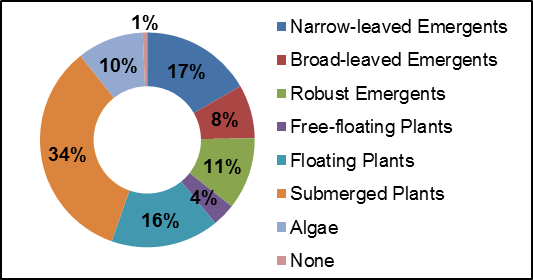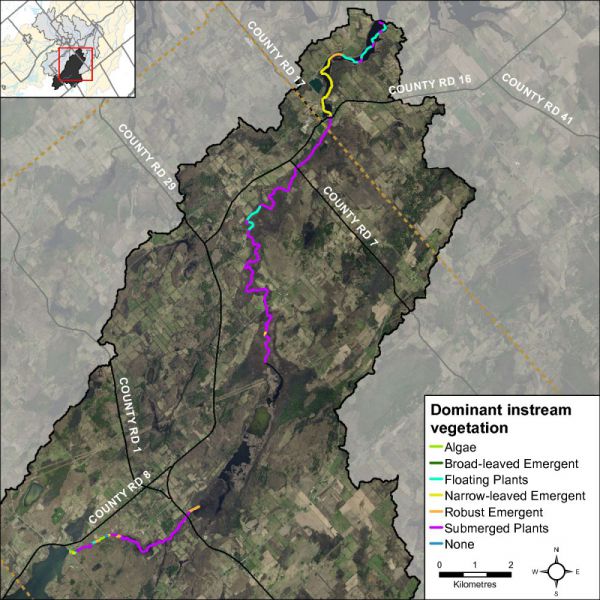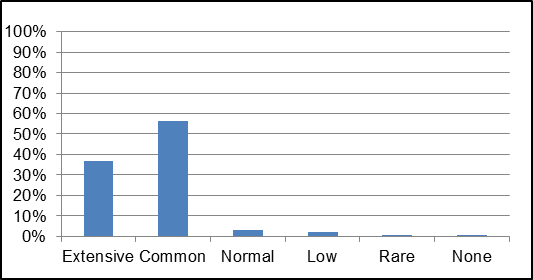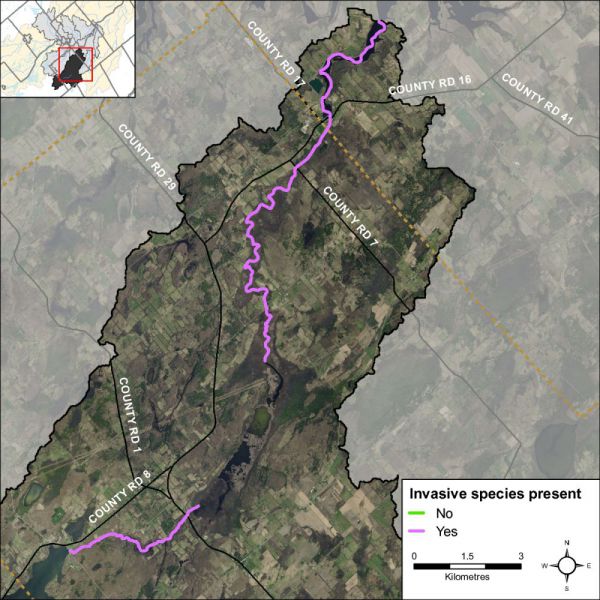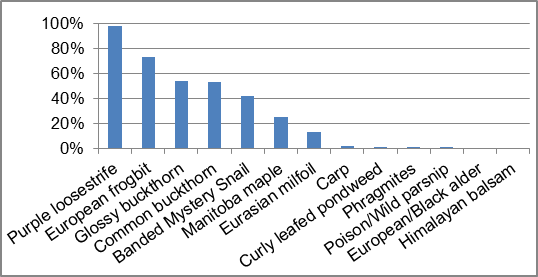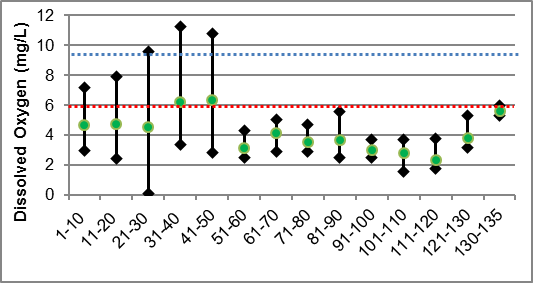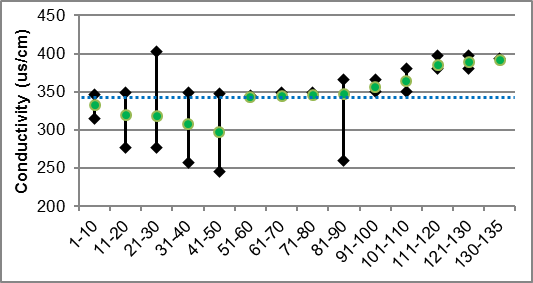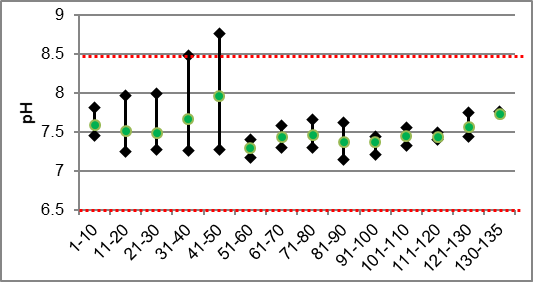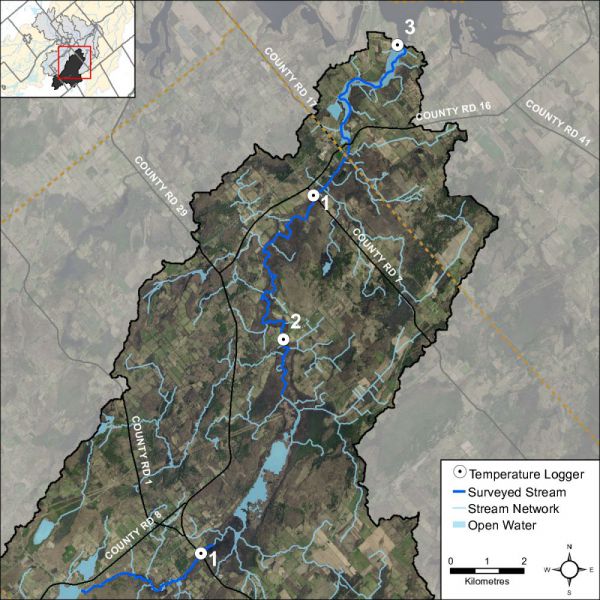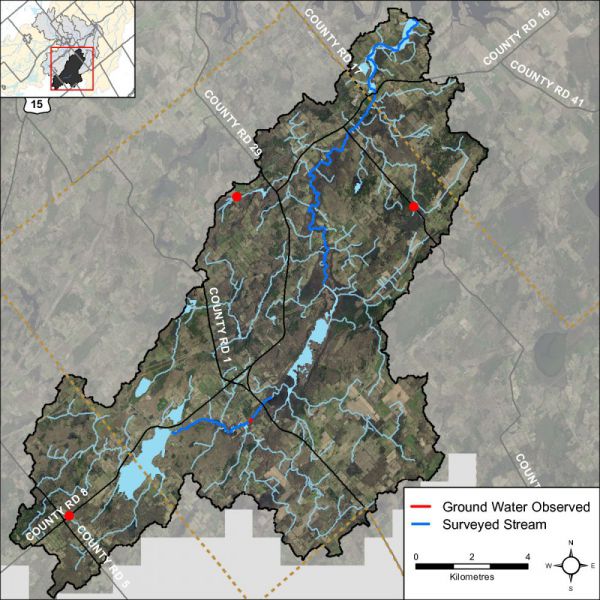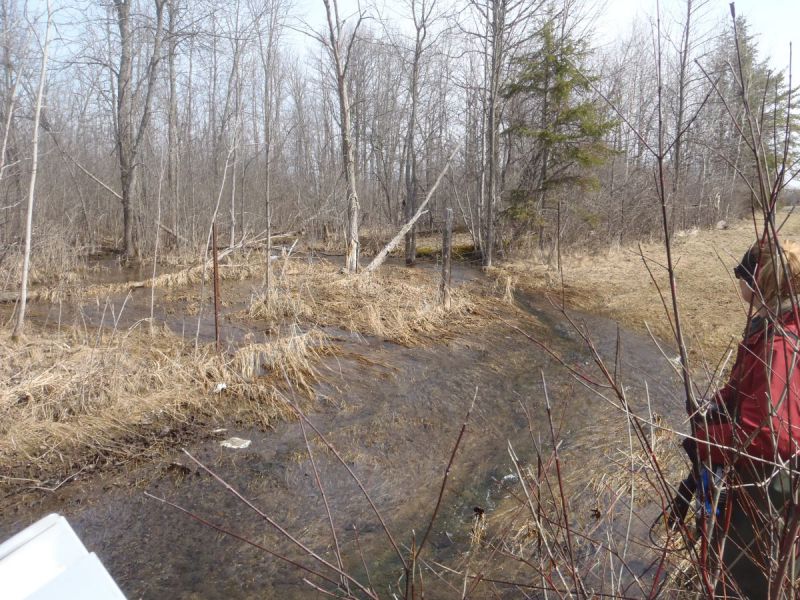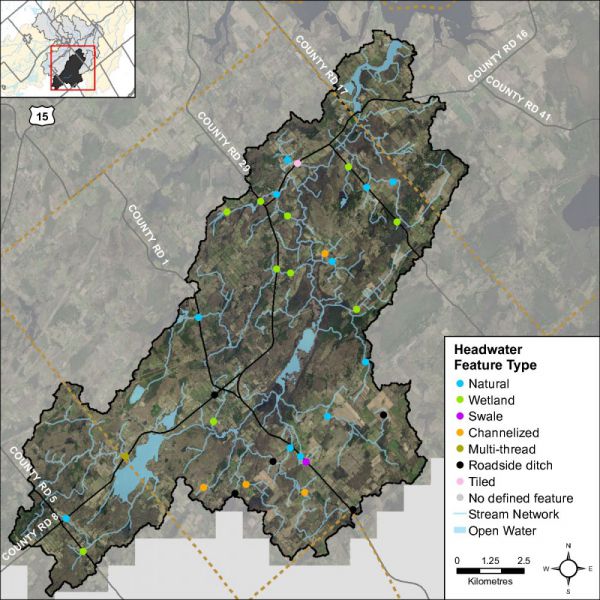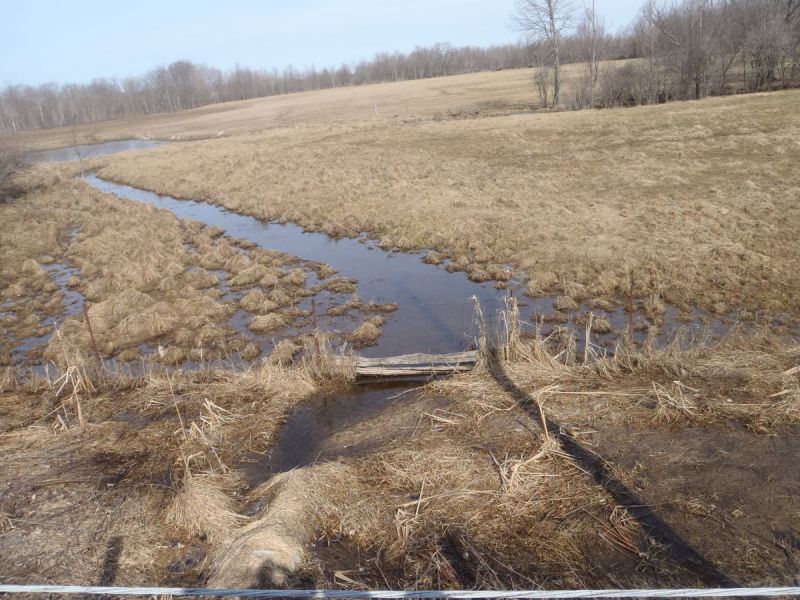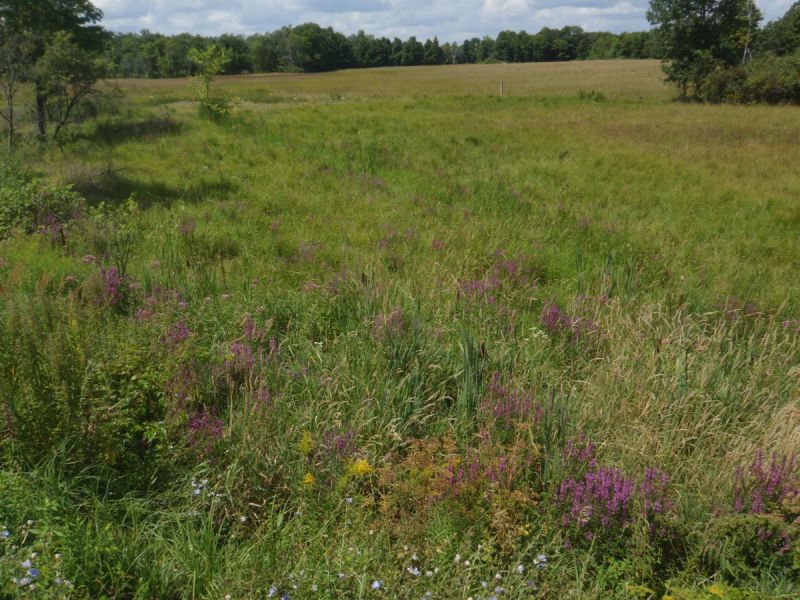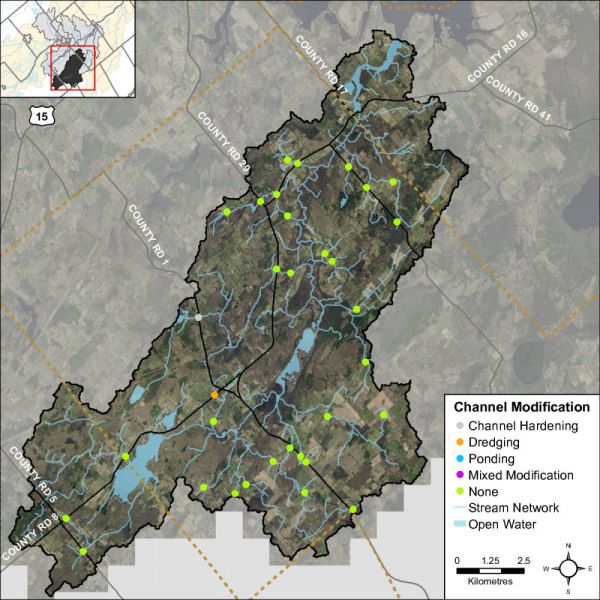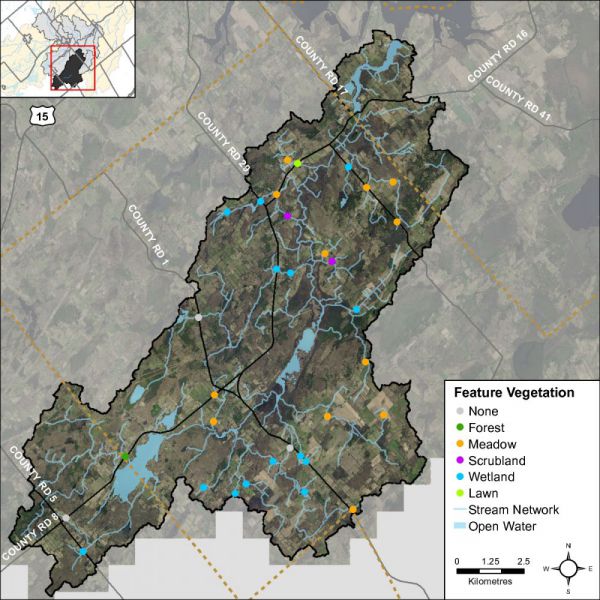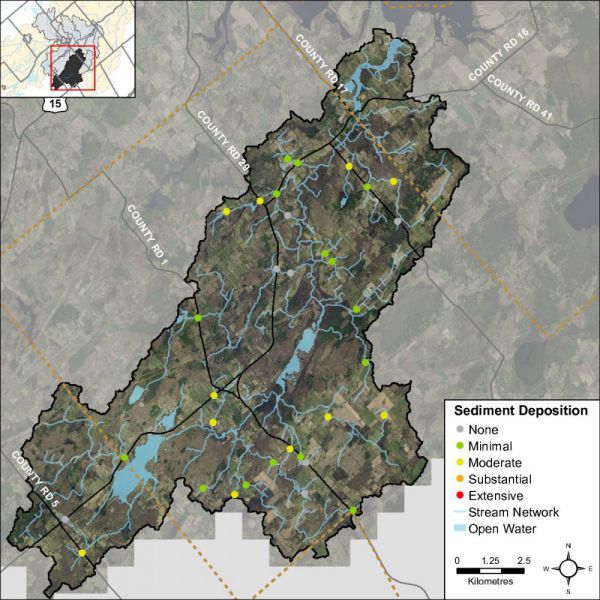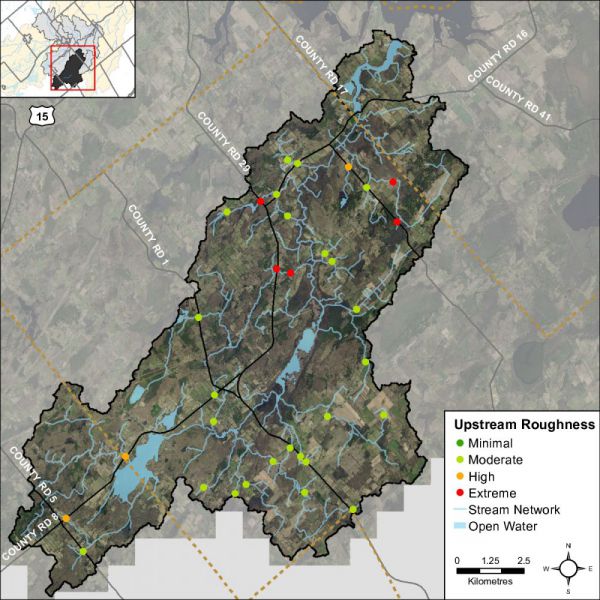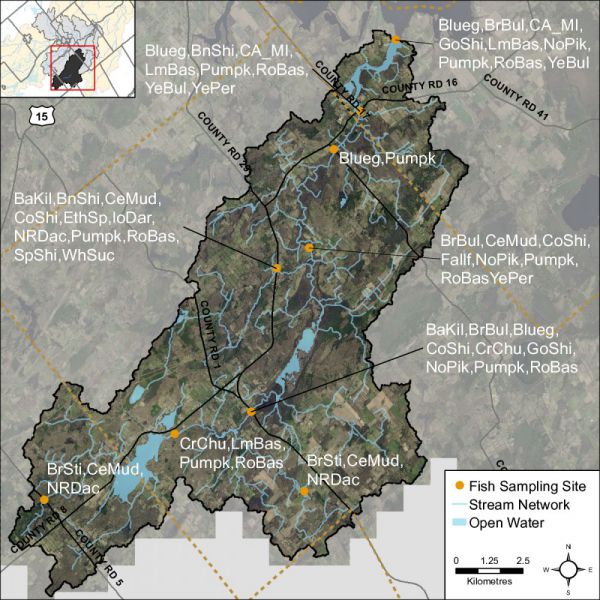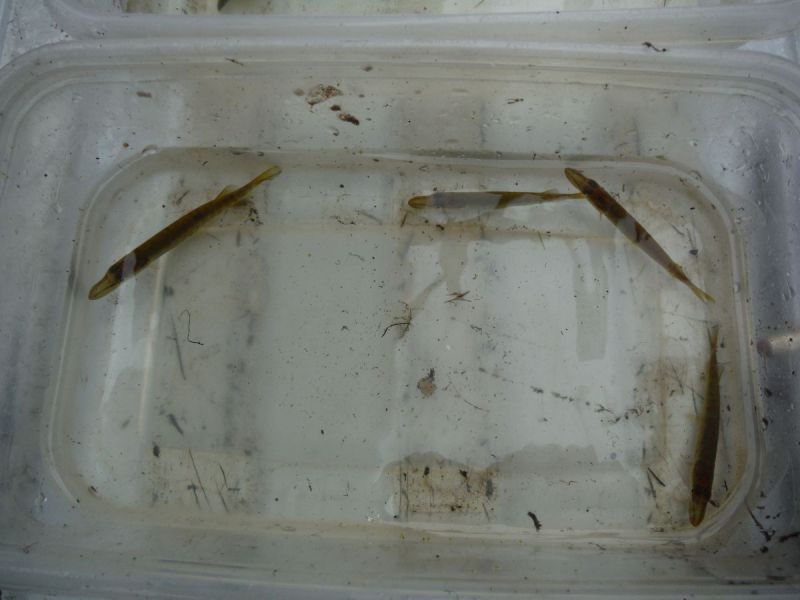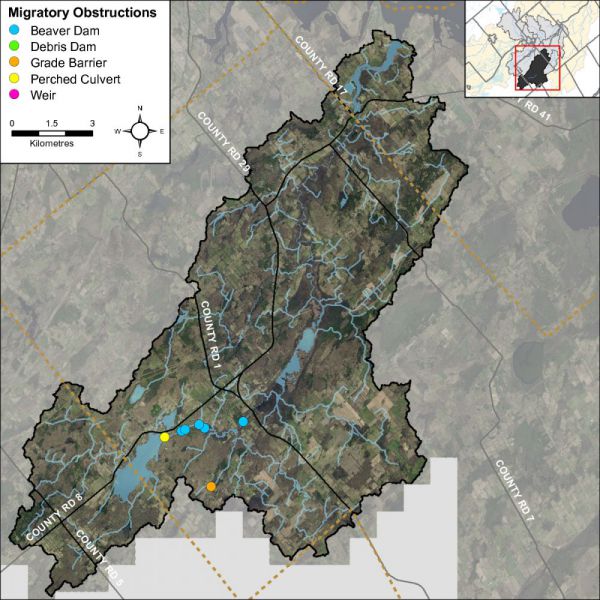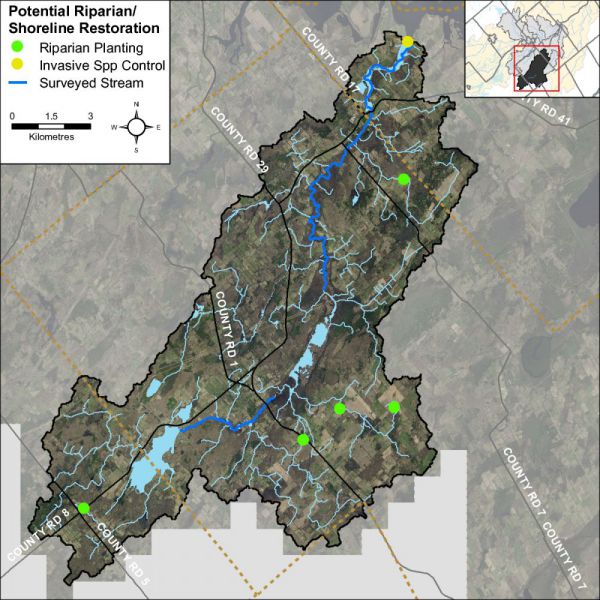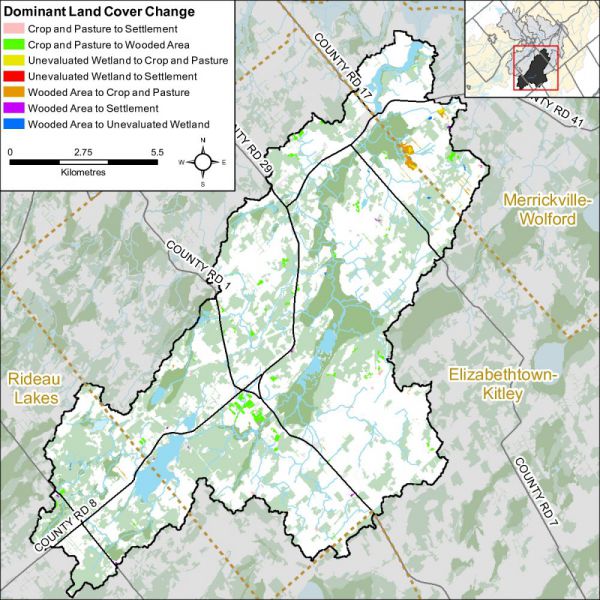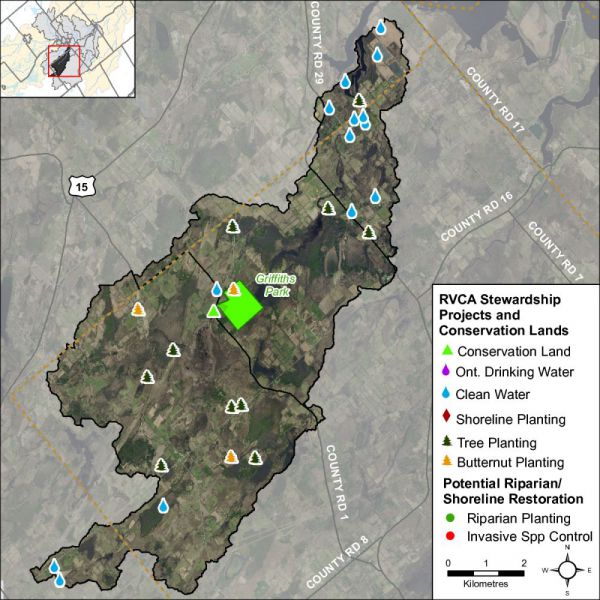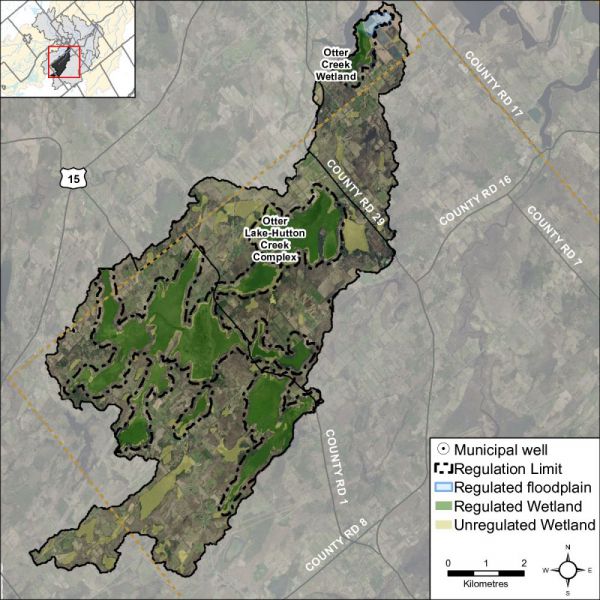2. Surface Water Quality Conditions
Surface water quality conditions in the Irish Creek catchment are monitored by the Rideau Valley Conservation Authority’s (RVCA) Baseline Water Quality Monitoring Program. The Baseline Water Quality Program focuses on streams; data is collected for 22 parameters including nutrients (total phosphorus, total Kjeldahl nitrogen and ammonia), E. coli, metals (like aluminum and copper) and additional chemical/physical parameters (such as alkalinity, chlorides, pH and total suspended solids). Figure 1 shows the location of the monitoring site in the catchment.
Figure 1 Water quality monitoring site on Irish Creek
Irish Creek Water Quality
Water Quality Rating
The water quality rating for the Irish Creek catchment is “Good” (Table 1) as determined by the Canadian Council of Ministers of the Environment (CCME) Water Quality Index and is largely influenced by occasionaly high nutrient concentrations and bacterial counts. A "Good" rating indicates water quality is protected with only a minor degree of threat or impairment; conditions rarely depart from natural or desireable levels. Each parameter is evaluated against established guidelines to determine water quality conditions. Those parameters that frequently exceed guidelines are presented below. Analysis of the data has been broken into two periods; 2003 to 2008 and 2009 to 2014 for the stream monitoring site located on Irish Creek (IRI-02) to examine if conditions have changed between these periods. Table 1 shows the overall rating for the monitored surface water quality site within the Irish Creek catchment and Table 2 outlines the Water Quality Index (WQI) scores and their corresponding ratings.
Table 1 Water Quality Index Ratings for the Irish Creek catchment
Table 2 WQI Ratings and corresponding index scores (RVCA terminology, original WQI category names in brackets)
Nutrients
Total phosphorus (TP) is used as a primary indicator of excessive nutrient loading and may contribute to abundant aquatic vegetation growth and depleted dissolved oxygen levels. The Provincial Water Quality Objective (PWQO) is used as the TP Guideline and states that in streams concentrations greater than 0.030 mg/l indicate an excessive amount of TP.
Total Kjeldahl nitrogen (TKN) and ammonia (NH3) are used as secondary indicators of nutrient loadings. RVCA uses a guideline of 0.500 mg/l to assess TKN[1] and the PWQO of 0.020 mg/l to assess NH3 concentrations in Dales Creek.
Tables 3, 4 and 5 summarize average nutrient concentrations at monitored sites within the Creek catchment and show the proportion of results that meet the guidelines.
Table 3 Summary of total phosphorus results for Irish Creek, 2003-2008 and 2009-2014
Table 4 Summary of total Kjeldahl Nitrogen results for Irish Creek, 2003-2008 and 2009-2014. Highlighted values indicate average concentrations exceed the guideline
Table 5 Summary of Ammonia results for Irish Creek, 2003-2008 and 2009-2014. Highlighted values indicate average concentrations exceed the guideline
Elevated TP results rarely exceeded the guideline in the 2003-2008 and 2009-2014 monitoring periods at site IRI-02. The 2009-2014 monitoring period saw an improvement with no exceedances. Site IRI-02 had 95 percent of samples that were below the guideline in the 2003-2008 period (Figure 2); this increased to 100 percent of samples in the 2009-2014 period (Figure 3). The average TP concentration for both reporting periods were below the PWQO which slightly decreased from 0.019 mg/l to 0.014 mg/l (Table 3).
Figure 2 Total Phosphorous concentrations in Irish Creek, 2003-2008
Figure 3 Total Phosphorous concentrations in Irish Creek, 2008-2014
TKN concentrations show that the bulk of results exceeded the guideline (Figures 4 and 5). There were few samples (24 percent) below the guideline in the 2003-2008 period and this slightly decreased to 22 percent in the 2009-2014 period. The average concentration was generally elevated and decreased from 0.669 mg/l to 0.608 mg/l (Table 8).
Figure 4 Total Kjeldahl nitrogen concentrations in Irish Creek, 2003-2008
Figure 5 Total Kjeldahl nitrogen concentrations in Irish Creek, 2008-2014
Occasional elevated nutrients were observed in NH3 data. The proportion of results that were below the guideline were 83 percent for both monitoring periods (Figures 6 and 7). The average NH3 concentration from 2003-2008 was 0.017 mg/l and decreased to 0.008 mg/l from 2009-2014. Both averages were below the guideline. (Table 5).
Figure 6 Ammonia concentrations in Irish Creek, 2003-2008
Figure 7 Ammonia concentrations in Irish Creek, 2009-2014
Summary
The data shows that nutrient enrichment is an occasional feature of Irish Creek. All nutrients decreased between the two reporting periods, with a majority of samples below the guidelines for both TP and NH3. Elevated TKN results were observed during both monitoring periods and have average concentrations that exceed the guidelines. These elevated results may be influenced by organic matter held by wetland areas found upstream in the Middle Rideau Subwatershed, resulting in naturally high concentrations of organic nitrogen. High nutrient concentrations can help stimulate the growth of algae blooms and other aquatic vegetation in a waterbody and deplete oxygen levels as the vegetation dies off. It is important to reduce human impacts wherever possible. Strategies to reduce nutrient inputs may include diversion of runoff to the creek and enhanced shoreline buffers.
E. Coli
E. coli is used as an indicator of bacterial pollution from human or animal waste; in elevated concentrations it can pose a risk to human health. The PWQO of 100 colony forming units/100 millilitres (CFU/100 ml) is used. E. coli counts greater than this guideline indicate that bacterial contamination may be a problem within a waterbody.
Table 6 summarizes the geometric mean[2] for the monitored site on Irish Creek and shows the proportion of samples that meet the E. coli guideline of 100 CFU/100 ml. The results of the geometric mean with respect to the guideline for the two periods, 2003-2008 and 2009- 2014, are shown in Figures 8 and 9 respectively.
Table 6 Summary of E. coli results for Irish Creek, 2003-2008 and 2009-2014
E. coli results at site IRI-02 indicate bacterial counts are rarely above the E. coli guideline. The proportion of samples below the guideline increased from 90 percent (Figure 8) to 95 percent (Figure 9). E.coli counts decreased between the two monitoring periods (2003-2008 and 2009-2014) with a geometric mean of 38 CFU/100ml to 25 CFU/100ml (Table 6).
Figure 8 E.coli counts in Irish Creek, 2003-2008
Figure 9 E.coli counts in Irish Creek, 2009-2014
Summary
This data shows that E.coli results rarely exceed the guidelines at site IRI-02 in Irish Creek. The geometric mean is below the PWQO for both monitoring periods and there has been a decrease in E.coli counts between 2003-2008 and 2009-2014. Properly maintaining septic systems, enhancing shoreline buffers and restricting cattle access can help to improve and maintain E.coli levels in Irish Creek.
[1] No Ontario guideline for TKN is presently available; however, waters not influenced by excessive organic inputs typically range from 0.100 to 0.500 mg/l, Environment Canada (1979) Water Quality Sourcebook, A Guide to Water Quality Parameters, Inland Waters Directorate, Water Quality Branch, Ottawa, Canada
[2] A type of mean or average, which indicates the central tendency or typical value of a set of numbers by using the product of their values (as opposed to the arithmetic mean which uses their sum). It is often used to summarize a variable that varies over several orders of magnitude, such as E. coli counts.
3. Irish Creek Riparian Conditions
Shoreline Buffer Land Cover Evaluation
The riparian or shoreline zone is that special area where the land meets the water. Well-vegetated shorelines are critically important in protecting water quality and creating healthy aquatic habitats, lakes and rivers. Natural shorelines intercept sediments and contaminants that could impact water quality conditions and harm fish habitat in streams. Well established buffers protect the banks against erosion, improve habitat for fish by shading and cooling the water and provide protection for birds and other wildlife that feed and rear young near water. A recommended target (from Environment Canada’s Guideline: How Much Habitat is Enough?) is to maintain a minimum 30 metre wide vegetated buffer along at least 75 percent of the length of both sides of rivers, creeks and streams.
Figure 10 shows the extent of the naturally vegetated riparian zone along a 30 metre deep/wide area of the shoreline of Irish Creek and its tributaries. This information is derived from a dataset developed by the RVCA’s Land Cover Classification Program through heads-up digitization of 20cm DRAPE ortho-imagery at a 1:4000 scale, which details the catchment landscape using 10 land cover classes.
Figure 10 Natural and other riparian land cover in the Irish Creek catchment
This analysis shows that the riparian buffer in the Irish Creek catchment is comprised of wetland (53 percent), crop and pastureland (25 percent), woodland (18 percent), roads (two percent) and settlement areas (two percent). Additional statistics for the Irish Creek catchment are presented in Table 7 and show that there has been very little change in shoreline cover from 2008 to 2014.
Table 7 Riparian land cover (2008 vs. 2014) in the Irish Creek catchment
Irish Creek Overbank Zone
Riparian Buffer Width Evaluation
Figure 11 demonstrates the buffer conditions of the left and right banks separately. Irish Creek had a buffer of greater than 30 meters along 97 percent of the right bank and 98 percent of the left bank.
Figure 11 Riparian buffer evaluation along Irish Creek
Adjacent Land Use
The RVCA’s Stream Characterization Program identifies six different land uses beside Irish Creek (Figure 12). Surrounding land use is considered from the beginning to end of the survey section (100m) and up to 100m on each side of the creek. Land use outside of this area is not considered for the surveys but is nonetheless part of the subwatershed and will influence the creek. Natural areas made up 95 percent of the stream, characterized by wetlands, forest, scrubland and meadow. Wetland habitat was dominant in the adjacent lands along Irish Creek at 80 percent. The remaining land use consisted of residential and infrastructure in the form of road crossings.
Figure 12 Land Use along Irish Creek
Irish Creek Shoreline Zone
Instream Erosion
Erosion is a normal, important stream process and may not affect actual bank stability; however, excessive erosion and deposition of sediment within a stream can have a detrimental effect on important fish and wildlife habitat. Poor bank stability can greatly contribute to the amount of sediment carried in a waterbody as well as loss of bank vegetation due to bank failure, resulting in trees falling into the stream and the potential to impact instream migration. Figure 13 shows low levels of erosion along Irish Creek.
Figure 13 Erosion along Irish Creek
Undercut Stream Banks
Undercut banks are a normal and natural part of stream function and can provide excellent refuge areas for fish. Figure 14 shows that Irish Creek had low levels of undercut banks along the system.
Figure 14 Undercut stream banks along Irish Creek
Stream Shading
Grasses, shrubs and trees all contribute towards shading a stream. Shade is important in moderating stream temperature, contributing to food supply and helping with nutrient reduction within a stream. Figure 15 shows low levels of stream shading dominate conditions in most reaches of Irish Creek.
Figure 15 Stream shading along Irish Creek
Instream Woody Debris
Figure 16 shows that the majority of Irish Creek had low to moderate levels of instream woody debris in the form of branches and trees. Instream woody debris is important for fish and benthic invertebrate habitat, by providing refuge and feeding areas.
Figure 16 Instream woody debris along Irish Creek
Overhanging Trees and Branches
Figure 17 shows the system is dominated by low to moderate levels of overhanging branches and trees along Irish Creek. Overhanging branches and trees provide a food source, nutrients and shade which helps to moderate instream water temperatures.
Figure 17 Overhanging trees and branches along Irish Creek
Anthropogenic Alterations
Figure 18 shows 94 percent of Irish Creek remains “unaltered” with no anthropogenic alterations. Five percent of Irish Creek was classified as natural with minor anthropogenic changes and one percent was considered altered in the form of road crossings.
Figure 18 Anthropogenic alterations along Irish Creek
Irish Creek Instream Aquatic Habitat
Benthic Invertebrates
Freshwater benthic invertebrates are animals without backbones that live on the stream bottom and include crustaceans such as crayfish, molluscs and immature forms of aquatic insects. Benthos represent an extremely diverse group of aquatic animals and exhibit wide ranges of responses to stressors such as organic pollutants, sediments and toxicants, which allows scientists to use them as bioindicators. As part of the Ontario Benthic Biomonitoring Network (OBBN), the RVCA has been collecting benthic invertebrates at the Kinch road site on Irish Creek since 2003. Monitoring data is analyzed for each sample site and the results are presented using the Family Biotic Index, Family Richness and percent Ephemeroptera, Plecoptera and Trichoptera.
Hilsenhoff Family Biotic Index
The Hilsenhoff Family Biotic Index (FBI) is an indicator of organic and nutrient pollution and provides an estimate of water quality conditions for each site using established pollution tolerance values for benthic invertebrates. FBI results for Irish Creek are separated by reporting period 2003 to 2008 and 2009 to 2014. “Poor” to “Very poor” water quality conditions being observed at the Irish Creek sample location for the period from 2003 to 2014 (Fig.19) using a grading scheme developed by Conservation Authorities in Ontario for benthic invertebrates.
Figure 19 Hilsenhoff Family Biotic Index on Irish Creek
Family Richness
Family Richness measures the health of the community through its diversity and increases with increasing habitat diversity suitability and healthy water quality conditions. Family Richness is equivalent to the total number of benthic invertebrate families found within a sample. Irish Creek is reported to have “Poor” to “Good” family richness (Fig.20).
Figure 20 Family Richness in Irish Creek
EPT
Ephemeroptera (Mayflies), Plecoptera (Stoneflies), and Trichoptera (Caddisflies) are species considered to be very sensitive to poor water quality conditions. High abundance of these organisms is generally an indication of good water quality conditions at a sample location. During more recent sampling years the community structure has been shifting to species that are more sensitive to poor water quality conditions. As a result, the EPT indicates that Irish Creek is reported to have “Poor” water quality (Fig.21) from 2003 to 2014.
Figure 21 EPT in Irish Creek
Conclusion
Overall Irish Creek aquatic habitat conditions from a benthic invertebrate perspective is considered “Poor” from 2003 to 2014 as the samples are dominated by species that are tolerant of high organic pollution levels.
Habitat Complexity
Streams are naturally meandering systems and move over time; there are varying degrees of habitat complexity, depending on the creek. Examples of habitat complexity include variable habitat types such as pools and riffles as well as substrate variability and woody debris structure. A high percentage of habitat complexity (heterogeneity) typically increases the biodiversity of aquatic organisms within a system. Forty percent of Irish Creek was considered heterogeneous, as shown in Figure 22. The majority of the Irish Creek system is classified as a riverine wetland.
Figure 22 Habitat complexity along Irish Creek
Instream Substrate
Diverse substrate is important for fish and benthic invertebrate habitat because some species have specific substrate requirements and for example will only reproduce on certain types of substrate. Figure 23 shows that 74 percent of the substrate observed on Irish Creek was dominated by silt and organic substrate consistent with wetland habitat conditions. Overall substrate conditions were fairly uniform along Irish Creek. Figure 24 shows the dominant substrate type observed for each section surveyed along Irish Creek.
Figure 23 Instream substrate along Irish Creek
Figure 24 shows the dominant substrate type along Irish Creek.
Cobble and Boulder Habitat
Boulders create instream cover and back eddies for large fish to hide and/or rest out of the current. Cobble provides important spawning habitat for certain fish species like walleye and various shiner species who are an important food source for larger fish. Cobble can also provide habitat conditions for benthic invertebrates that are a key food source for many fish and wildlife species. Figure 25 shows where cobble and boulder substrate are found in Irish Creek.
Figure 25 Instream substrate cobble and boulder along Irish Creek
Instream Morphology
Pools and riffles are important habitat features for fish. Riffles are areas of agitated water and they contribute higher dissolved oxygen to the stream and act as spawning substrate for some species of fish, such as walleye. Pools provide shelter for fish and can be refuge pools in the summer if water levels drop and water temperature in the creek increases. Pools also provide important over wintering areas for fish. Runs are usually moderately shallow, with unagitated surfaces of water and areas where the thalweg (deepest part of the channel) is in the center of the channel. Figure 26 shows that Irish Creek is fairly uniform; 83 percent consists of runs, 1 percent riffles and 16 percent pools. Figure 27 shows where the limited areas of riffle habitat were observed along Irish Creek.
Figure 26 Instream morphology along Irish Creek
Figure 27 Riffle habitat locations along Irish Creek
Vegetation Type
Instream vegetation provides a variety of functions and is a critical component of the aquatic ecosystem. For example emergent plants along the shoreline can provide shoreline protection from wave action and important rearing habitat for species of waterfowl. Submerged plants provide habitat for fish to find shelter from predator fish while they feed. Floating plants such as water lilies shade the water and can keep temperatures cool while reducing algae growth. The dominant vegetation type recorded at 34 percent consisted of submerged plants. Irish Creek had high levels of diversity for instream vegetation. Figure 28 depicts the plant community structure for Irish Creek. Figure 29 shows the dominant vegetation type observed for each section surveyed along Irish Creek.
Figure 28 Vegetation type along Irish Creek
Figure 29 Dominant vegetation type along Irish Creek
Instream Vegetation Abundance
Instream vegetation is an important factor for a healthy stream ecosystem. Vegetation helps to remove contaminants from the water, contributes oxygen to the stream, and provides habitat for fish and wildlife. Too much vegetation can also be detrimental. Figure 30 demonstrates that Irish Creek had common and normal levels of instream vegetation for 60 percent of its length. Extensive vegetation levels were recorded at 37 percent of stream surveys, which can result in low oxygen levels along the system.
Figure 30 Instream vegetation abundance along Irish Creek
Invasive Species
Invasive species can have major implications on streams and species diversity. Invasive species are one of the largest threats to ecosystems throughout Ontario and can out compete native species, having negative effects on local wildlife, fish and plant populations. One hundred percent of the sections surveyed along Irish Creek had invasive species (Figure 31). The invasive species observed in Irish Creek were European frogbit, purple loosestrife, glossy and common buckthorn, poison/wild parsnip, carp, banded mystery snail, curly leafed pondweed, Himalayan balsam, phragmites, European/Black alder, Eurasian milfoil and Manitoba maple. Figure 32 shows the frequency of the invasive species observed along Irish Creek.
Figure 31 Invasive species along Irish Creek
Figure 32 Frequency of the invasive species observed along Irish Creek
Water Chemistry
During the stream characterization survey, a YSI probe is used to collect water chemistry information. Dissolved oxygen, conductivity and pH are measured at the start and end of each section.
Dissolved Oxygen
Dissolved oxygen is a measure of the amount of oxygen dissolved in water. The Canadian Environmental Quality Guidelines of the Canadian Council of Ministers of the Environment (CCME) suggest that for the protection of aquatic life the lowest acceptable dissolved oxygen concentration should be 6 mg/L for warmwater biota and 9.5 mg/L for coldwater biota (CCME, 1999). Figure 33 shows that the dissolved oxygen in Irish Creek was below the threshold for warmwater biota in most reaches of the system. The average dissolved oxygen levels observed within the main stem of Irish Creek was 4.19 mg/L which is below the recommended levels for warmwater biota.
Figure 33 Dissolved oxygen ranges in Irish Creek
Conductivity
Conductivity in streams is primarily influenced by the geology of the surrounding environment, but can vary drastically as a function of surface water runoff. Currently there are no CCME guideline standards for stream conductivity; however readings which are outside the normal range observed within the system are often an indication of unmitigated discharge and/or stormwater input. The average conductivity observed within the main stem of Irish Creek was 345.8 µs/cm. Figure 34 shows the conductivity readings for Irish Creek.
Figure 34 Specific conductivity ranges in Irish Creek
pH
Based on the PWQO for pH, a range of 6.5 to 8.5 should be maintained for the protection of aquatic life. Average pH values for Irish Creek averaged 7.52 thereby meeting the provincial standard (Figure 35).
Figure 35 pH ranges in Irish Creek
Thermal Regime
Many factors can influence fluctuations in stream temperature, including springs, tributaries, precipitation runoff, discharge pipes and stream shading from riparian vegetation. Water temperature is used along with the maximum air temperature (using the Stoneman and Jones method) to classify a watercourse as either warm water, cool water or cold water. Figure 36 shows where the thermal sampling sites were located along Irish Creek and Marshalls Creek. Analysis of the data collected indicates that Irish Creek is classified as a warm water system with cool water reaches (Figure 37).
Figure 36 Temperature logger locations on Irish Creek and Marshalls Creek
Figure 37 Temperature logger data for three sites on Irish Creek.
Each point on the graph represents a temperature that meets the following criteria:
- Sampling dates between July 1st and September 7th
- Sampling date is preceded by two consecutive days above 24.5 °C, with no rain
- Water temperatures are collected at 4pm
- Air temperature is recorded as the max temperature for that day
Groundwater
Groundwater discharge areas can influence stream temperature, contribute nutrients, and provide important stream habitat for fish and other biota. During stream surveys, indicators of groundwater discharge are noted when observed. Indicators include: springs/seeps, watercress, iron staining, significant temperature change and rainbow mineral film. Figure 38 shows areas where one or more of the above groundwater indicators were observed during stream surveys and headwater assessments.
Figure 38 Groundwater indicators observed in the Irish Creek catchment
Headwaters Drainage Features Assessment
The RVCA Stream Characterization program assessed Headwater Drainage Features for the Middle Irish subwatershed in 2014. This protocol measures zero, first and second order headwater drainage features (HDF). It is a rapid assessment method characterizing the amount of water, sediment transport, and storage capacity within headwater drainage features (HDF). RVCA is working with other Conservation Authorities and the Ministry of Natural Resources and Forestry to implement the protocol with the goal of providing standard datasets to support science development and monitoring of headwater drainage features. An HDF is a depression in the land that conveys surface flow. Additionally, this module provides a means of characterizing the connectivity, form and unique features associated with each HDF (OSAP Protocol, 2013). In 2014 the program sampled 34 sites at road crossings in the Irish Creek catchment area (Figure 39).
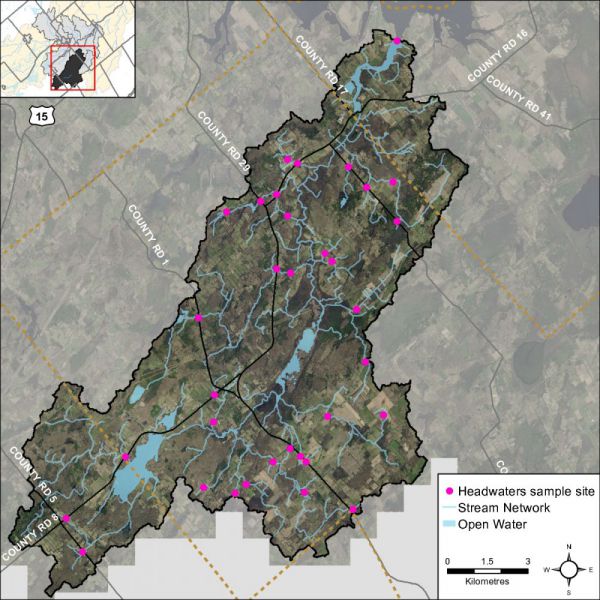
Figure 39 Locations of the headwater sampling sites in the Irish Creek catchment
RVCA staff sampling a headwater sample site in the Irish Creek catchment
Feature Type
The headwater sampling protocol assesses the feature type in order to understand the function of each feature. The evaluation includes the following classifications: defined natural channel, channelized or constrained, multi-thread, no defined feature, tiled, wetland, swale, roadside ditch and pond outlet. By assessing the values associated with the headwater drainage features in the catchment area we can understand the ecosystem services that they provide to the watershed in the form of hydrology, sediment transport, and aquatic and terrestrial functions. The Irish Creek catchment is dominated by wetland and natural headwater drainage features. Four features were classified as having been channelized , five features were identified as roadside drainage features and one feature was tile drained. Figure 40 shows the feature type of the primary feature at the sampling locations.
Figure 40 Headwater feature types in the Irish Creek catchment
Headwater Feature Flow
The observed flow condition within headwater drainage features can be highly variable depending on timing relative to the spring freshet, recent rainfall, soil moisture, etc. Flow conditions are assessed in the spring and in the summer to determine if features are perennial and flow year round, if they are intermittent and dry up during the summer months or if they are ephemeral systems that do not flow regularly and generally respond to specific rainstorm events or snowmelt. Flow conditions in headwater systems can change from year to year depending on local precipitation patterns. Figure 41 shows the observed flow conditions at the sampling locations in the Irish Creek catchment in 2014.
Figure 41 Headwater feature flow conditions in the Irish Creek catchment
A spring photo of the headwater sample site in the Irish Creek catchment located on County Road 8
A summer photo of the headwater sample site in the Irish Creek catchment located on County Road 8
Feature Channel Modifications
Channel modifications were assessed at each headwater drainage feature sampling location. Modifications include channelization, dredging, hardening and realignments. The majority of sampling locations for the Irish Creek catchment area were classified as having no channel modifications, one channel was classified as being hardened and one appeared to have been historically dredged. Figure 42 shows the channel modifications observed at the sampling locations for Irish Creek.
Figure 42 Headwater feature channel modifications in the Irish Creek catchment
Headwater Feature Vegetation
Headwater feature vegetation evaluates the type of vegetation that is found within the drainage feature. The type of vegetated within the channel influences the aquatic and terrestrial ecosystem values that the feature provides. For some types of headwater features the vegetation within the feature plays a very important role in flow and sediment movement and provides wildlife habitat. The following classifications are evaluated no vegetation, lawn, wetland, meadow, scrubland and forest. The features assessed in the Irish Creek catchment were classified being dominated by wetland, scrubland, meadow and forest. One feature was classified as having lawn. Figure 43. Depicts the dominant vegetation observed at the sampled headwater sites in the Irish Creek catchment.
Figure 43 Headwater feature vegetation types in the Irish Creek catchment
Headwater Feature Riparian Vegetation
Headwater riparian vegetation evaluates the type of vegetation that is found along the adjacent lands of a headwater drainage feature. The type of vegetation within the riparian corridor influences the aquatic and terrestrial ecosystem values that the feature provides to the watershed. The sample locations in Irish Creek were dominated by natural vegetation in the form of meadow, scrubland, forest and wetland vegetation. Figure 44. Depicts the type of riparian vegetation observed at the sampled headwater sites in the Irish Creek catchment.
Figure 44 Headwater feature riparian vegetation types in the Irish Creek catchment
Headwater Feature Sediment Deposition
Assessing the amount of recent sediment deposited in a channel provides an index of the degree to which the feature could be transporting sediment to downstream reaches (OSAP, 2013). Evidence of excessive sediment deposition might indicate the requirement to follow up with more detailed targeted assessments upstream of the site location to identify potential best management practices to be implemented. Conditions ranged from no deposition observed to moderate deposition recorded. Figure 45. Depicts the degree of sediment deposition observed at the sampled headwater sites in the Irish Creek catchment.
Figure 45 Headwater feature sediment deposition in the Irish Creek catchment
Headwater Feature Upstream Roughness
Feature roughness will provide a measure of the amount of materials within the bankfull channel that could slow down the velocity of water flowing within the headwater feature (OSAP, 2013). Materials on the channel bottom that provide roughness include vegetation, woody debris and boulders/cobble substrates. Roughness can provide benefits in mitigating downstream erosion on the headwater drainage feature and the receiving watercourse by reducing velocities. Roughness also provides important habitat conditions to aquatic organisms. The sample locations in the Irish Creek catchment area ranged from moderate to extreme roughness conditions. Figure 46 shows the feature roughness conditions at the sampling locations in the Irish Creek catchment.
Figure 46 Headwater feature roughness in the Irish Creek catchment
Fish Community
The Irish Creek catchment is classified as a mixed community of warm and cool water recreational and baitfish fishery with 22 species observed. Table 8 lists those species observed in the catchment (Source: MNR/RVCA). Figure 47 shows the sampling locations along Irish Creek.
Figure 47 Irish Creek fish community
Table 8 Fish species observed in Irish Creek
RVCA staff set fyke nets along the system to sample fish in Irish Creek
Young of the year northern pike captured along Irish Creek
Migratory Obstructions
It is important to know locations of migratory obstructions because these can prevent fish from accessing important spawning and rearing habitat. Migratory obstructions can be natural or manmade, and they can be permanent or seasonal. Figure 48 shows that Irish Creek had multiple beaver dams, one perched culvert and one grade barrier at the time of the survey in 2014.
Figure 48 Migratory obstructions along Irish Creek
Riparian Restoration
Figure 49 depicts the location of a riparian restoration opportunity as a result of observations made during the stream survey and headwater drainage feature assessments.
Figure 49 Riparian restoration opportunities along Irish Creek
4. Land Cover
Land cover and any change in coverage that has occurred over a six year period is summarized for the Irish Creek catchment using spatially continuous vector data representing the catchment during the spring of 2008 and 2014. This dataset was developed by the RVCA through heads-up digitization of 20cm DRAPE ortho-imagery at a 1:4000 scale and details the surrounding landscape using 10 land cover classes.
As shown in Table 9, the dominant land cover types in 2008 and 2014 were crop and pastureland along with woodland.
Table 9 Land cover (2008 vs. 2014) in the Irish Creek catchment
* Does not include treed swamps ** Includes treed swamps
From 2008 to 2014, there was an overall change of 195 hectares (from one land cover class to another). Most of the change is associated with crop and pastureland (i.e., previously cultivated areas/fallow fields) emerging as young woodland (i.e., regenerative and/or plantation) along with some smaller areas of woodland conversion to crop and pastureland (see Figure 50 for the location of the major changes).
Figure 50 Dominant land cover change in the Irish Creek catchment (2014)
Table 10 shows the type of land cover change that has taken place between land cover classes/types from 2008 to 2014. Overall, the net area of crop and pastureland change (loss) is small at 96 hectares relative to the remaining area of crop and pastureland in the catchment (as of 2014). Similarly, the net area of woodland change (gain) is also small at 80 hectares relative to the remaining area of woodland in the catchment (as of 2014), as is the change (gain) in the area of settlement (at 19 hectares) when compared to the remaining settlement (in 2014).
Table 10 Land cover change in the Irish Creek catchment (2008 to 2014)
Woodland Cover
In the Environment Canada Guideline (Third Edition) entitled “How Much Habitat Is Enough?” (hereafter referred to as the “Guideline”) the opening narrative under the Forest Habitat Guidelines section states that prior to European settlement, forest was the predominant habitat in the Mixedwood Plains ecozone. The remnants of this once vast forest now exist in a fragmented state in many areas (including the Rideau Valley watershed) with woodland patches of various sizes distributed across the settled landscape along with higher levels of forest cover associated with features such as the Frontenac Axis (within the on-Shield areas of the Rideau Lakes and Tay River subwatersheds). The forest legacy, in terms of the many types of wildlife species found, overall species richness, ecological functions provided and ecosystem complexity is still evident in the patches and regional forest matrices (found in the Middle Rideau subwatershed and elsewhere in the Rideau Valley watershed). These ecological features are in addition to other influences which forests have on water quality and stream hydrology including reducing soil erosion, producing oxygen, storing carbon along with many other ecological services that are essential not only for wildlife but for human well-being.
The Guideline also notes that forests provide a great many habitat niches that are in turn occupied by a great diversity of plant and animal species. They provide food, water and shelter for these species - whether they are breeding and resident locally or using forest cover to help them move across the landscape. This diversity of species includes many that are considered to be species at risk. Furthermore, from a wildlife perspective, there is increasing evidence that the total forest cover in a given area is a major predictor of the persistence and size of bird populations, and it is possible or perhaps likely that this pattern extends to other flora and fauna groups. The overall effect of a decrease in forest cover on birds in fragmented landscapes is that certain species disappear and many of the remaining ones become rare, or fail to reproduce, while species adapted to more open and successional habitats, as well as those that are more tolerant to human-induced disturbances in general, are able to persist and in some cases thrive. Species with specialized-habitat requirements are most likely to be adversely affected. The overall pattern of distribution of forest cover, the shape, area and juxtaposition of remaining forest patches and the quality of forest cover also play major roles in determining how valuable forests will be to wildlife and people alike.
The current science generally supports minimum forest habitat requirements between 30 and 50 percent, with some limited evidence that the upper limit may be even higher, depending on the organism/species phenomenon under investigation or land-use/resource management planning regime being considered/used.
As shown in Figure 51, 38 percent of the Irish Creek catchment contains 5522 hectares of upland forest and 624 hectares of lowland forest (treed swamps) versus the 34 percent of woodland cover in the Middle Rideau subwatershed. This is greater than the 30 percent of forest cover that is identified as the minimum threshold required to sustain forest birds according to the Guideline and which may only support less than one half of potential species richness and marginally healthy aquatic systems. When forest cover drops below 30 percent, forest birds tend to disappear as breeders across the landscape.
Figure 51 Woodland cover and forest interior (2014)
Woodland (Patch) Size
According to the Ministry of Natural Resources’ Natural Heritage Reference Manual (Second Edition), larger woodlands are more likely to contain a greater diversity of plant and animal species and communities than smaller woodlands and have a greater relative importance for mobile animal species such as forest birds.
Bigger forests often provide a different type of habitat. Many forest birds breed far more successfully in larger forests than they do in smaller woodlots and some rely heavily on forest interior conditions. Populations are often healthier in regions with more forest cover and where forest fragments are grouped closely together or connected by corridors of natural habitat. Small forests support small numbers of wildlife. Some species are “area-sensitive” and tend not to inhabit small woodlands, regardless of forest interior conditions. Fragmented habitat also isolates local populations, especially small mammals, amphibians and reptiles with limited mobility. This reduces the healthy mixing of genetic traits that helps populations survive over the long run (Conserving the Forest Interior. Ontario Extension Notes, 2000).
The Environment Canada Guideline also notes that for forest plants that do not disperse broadly or quickly, preservation of some relatively undisturbed large forest patches is needed to sustain them because of their restricted dispersal abilities and specialized habitat requirements and to ensure continued seed or propagation sources for restored or regenerating areas nearby.
The Natural Heritage Reference Manual continues by stating that a larger size also allows woodlands to support more resilient nutrient cycles and food webs and to be big enough to permit different and important successional stages to co-exist. Small, isolated woodlands are more susceptible to the effects of blowdown, drought, disease, insect infestations, and invasions by predators and non-indigenous plants. It is also known that the viability of woodland wildlife depends not only on the characteristics of the woodland in which they reside, but also on the characteristics of the surrounding landscape where the woodland is situated. Additionally, the percentage of forest cover in the surrounding landscape, the presence of ecological barriers such as roads, the ability of various species to cross the matrix surrounding the woodland and the proximity of adjacent habitats interact with woodland size in influencing the species assemblage within a woodland.
In the Irish Creek catchment (in 2014), 140 (35 percent) of the 393 woodland patches are very small, being less than one hectare in size. Another 199 (51 percent) of the woodland patches ranging from one to less than 20 hectares in size tend to be dominated by edge-tolerant bird species. The remaining 54 (14 percent of) woodland patches range between 20 and 550 hectares in size. Forty of these patches contain woodland between 20 and 100 hectares and may support a few area-sensitive species and some edge intolerant species, but will be dominated by edge tolerant species.
Conversely, fourteen (four percent) of the 393 woodland patches in the drainage area exceed the 100 plus hectare size needed to support most forest dependent, area sensitive birds and are large enough to support approximately 60 percent of edge-intolerant species. Seven patches top 200 hectares, which according to the Environment Canada Guideline will support 80 percent of edge-intolerant forest bird species (including most area sensitive species) that prefer interior forest habitat conditions.
Table 11 presents a comparison of woodland patch size in 2008 and 2014 along with any changes that have occurred over that time. An increase (of 80 ha) has been observed in the overall woodland patch area between the two reporting periods with most of the physical change in area occurring in the 50 to 100 and 100 to 200 hectare woodland patch size class ranges.
Table 11 Woodland patches in the Irish Creek catchment (2008 and 2014)
*Includes treed swamps
Forest Interior
The forest interior is habitat deep within woodlands. It is a sheltered, secluded environment away from the influence of forest edges and open habitats. Some people call it the “core” or the “heart” of a woodland. The presence of forest interior is a good sign of woodland health, and is directly related to the woodland’s size and shape. Large woodlands with round or square outlines have the greatest amount of forest interior. Small, narrow woodlands may have no forest interior conditions at all. Forest interior habitat is a remnant natural environment, reminiscent of the extensive, continuous forests of the past. This increasingly rare forest habitat is now a refuge for certain forest-dependent wildlife; they simply must have it to survive and thrive in a fragmented forest landscape (Conserving the Forest Interior. Ontario Extension Notes, 2000).
The Natural Heritage Reference Manual states that woodland interior habitat is usually defined as habitat more than 100 metres from the edge of the woodland and provides for relative seclusion from outside influences along with a moister, more sheltered and productive forest habitat for certain area sensitive species. Woodlands with interior habitat have centres that are more clearly buffered against the edge effects of agricultural activities or more harmful urban activities than those without.
In the Irish Creek catchment (in 2014), the 393 woodland patches contain 190 forest interior patches (Figure 51) that occupy seven percent (1213 ha.) of the catchment land area (which is greater than the five percent of interior forest in the Middle Rideau Subwatershed). This is below the ten percent figure referred to in the Environment Canada Guideline that is considered to be the minimum threshold for supporting edge intolerant bird species and other forest dwelling species in the landscape.
Most patches (163) have less than 10 hectares of interior forest, 111 of which have small areas of interior forest habitat less than one hectare in size. The remaining 27 patches contain interior forest ranging between 11 and 177 hectares in area.
Between 2008 and 2014, there has been a notable change in the number of woodland patches containing smaller areas of interior habitat (Table 12) with an increase of 80 woodlands containing less than one hectare of interior forest over this period and 19 woodlands with one to 10 hectares of interior habitat. This has occurred as a result of the loss of interior forest habitat in the larger woodland patches in the catchment over this period.
Table 12 Woodland Interior in the Irish Creek catchment (2008 and 2014)
Wetland Cover
Wetlands are habitats forming the interface between aquatic and terrestrial systems. They are among the most productive and biologically diverse habitats on the planet. By the 1980s, according to the Natural Heritage Reference Manual, 68 percent of the original wetlands south of the Precambrian Shield in Ontario had been lost through encroachment, land clearance, drainage and filling.
Wetlands perform a number of important ecological and hydrological functions and provide an array of social and economic benefits that society values. Maintaining wetland cover in a watershed provides many ecological, economic, hydrological and social benefits that are listed in the Reference Manual and which may include:
- contributing to the stabilization of shorelines and to the reduction of erosion damage through the mitigation of water flow and soil binding by plant roots
- mitigating surface water flow by storing water during periods of peak flow (such as spring snowmelt and heavy rainfall events) and releasing water during periods of low flow (this mitigation of water flow also contributes to a reduction of flood damage)
- contributing to an improved water quality through the trapping of sediments, the removal and/or retention of excess nutrients, the immobilization and/or degradation of contaminants and the removal of bacteria
- providing renewable harvesting of timber, fuel wood, fish, wildlife and wild rice
- contributing to a stable, long-term water supply in areas of groundwater recharge and discharge
- providing a high diversity of habitats that support a wide variety of plants and animals
- acting as “carbon sinks” making a significant contribution to carbon storage
- providing opportunities for recreation, education, research and tourism
Historically, the overall wetland coverage within the Great Lakes basin exceeded 10 percent, but there was significant variability among watersheds and jurisdictions, as stated in the Environment Canada Guideline. In the Rideau Valley Watershed, it has been estimated that pre-settlement wetland cover averaged 35 percent using information provided by Ducks Unlimited Canada (2010) versus the 21 percent of wetland cover existing in 2014 derived from DRAPE imagery analysis.
Using the same dataset, it is estimated that pre-settlement (historic) wetland cover averaged 32 percent in the Middle Rideau subwatershed versus the 27 percent of cover existing in 2014. This decline in wetland cover is also evident in the Irish Creek catchment (as seen in Figure 52) where there has been a two percent decrease in the area of wetland cover from pre-settlement times to the present (as summarized in Table 13).
Figure 52 Wetland cover in the Middle Rideau subwatershed and Irish Creek catchment (Historic to 2014)
While there has been a reported decrease in wetland cover in the Irish Creek catchment from pre-settlement times, the remaining wetland cover in 2014 remains above the ecological thresholds cited in the Environment Canada Guideline. Nonetheless, in order to maintain critical hydrological, ecological functions along with related recreational and economic benefits provided by these wetland habitats in the catchment, a “no net loss” of currently existing wetlands should be employed to ensure the continued provision of tangible benefits accruing from them for landowners and surrounding communities.
Table 13 Wetland cover in the Middle Rideau subwatershed and Irish Creek catchment (Historic to 2014)
5. Stewardship and Protection
The RVCA and its partners are working to protect and enhance environmental conditions in the Middle Rideau Subwatershed. Figure 53 shows the location of all stewardship projects completed in the Irish Creek catchment along with sites identified for potential shoreline restoration.
Rural Clean Water Projects
From 2009 to 2014, four septic system replacements, two well decommissionings, two well replacements and one education initiative were completed. Between 2003 and 2008, one septic system replacement, one well decommissioning, one clean water diversion and one fuel storage and handling facility were carried out along with one livestock fencing project prior to 2003. Total value of all 14 projects is $100,445 with $33,009 of that amount funded through grant dollars from the RVCA.
Figure 53 Stewardship and potential restoration locations
Tree Planting Projects
The location of RVCA Tree Planting Program projects is shown in Figure 53. From 2009 to 2014, 34,370 trees were planted at five sites. Between 2003 and 2008, 84,700 trees were planted at 16 sites and prior to 2003, 27,400 trees were planted at three sites, resulting in the reforestation of 75 hectares. Total value of all 24 projects is $515,140 with $171,776 of that amount coming from various fundraising sources.
Through the RVCA Butternut Recovery Program, an additional 75 butternut trees were planted in the Irish Creek catchment between 2003 and 2014, as part of efforts to introduce healthy seedlings from tolerant butternuts into various locations across Eastern Ontario.
Shoreline Naturalization Projects
With the assistance of the RVCA’s Shoreline Naturalization Program, 430 trees and shrubs were planted at one project location to create a 120 metre long shoreline buffer at a total project value of $1,068.
Valley, Stream, Wetland and Hazard Land Regulation
The Irish Creek catchment covers 161 square kilometres with 38.3 square kilometres (or 24 percent) of the drainage area being within the regulation limit of Ontario Regulation 174/06 (Figure 54), giving protection to wetland areas and river or stream valleys that are affected by flooding and erosion hazards.
Wetlands occupy 32.7 sq. km. (or 20 percent) of the catchment. Of these wetlands, 20.5 sq. km (or 63 percent) are designated as provincially significant and included within the RVCA regulation limit. This leaves the remaining 12.1 sq. km (or 37 percent) of wetlands in the catchment outside the regulated area limit.
Of the 232.6 kilometres of stream in the catchment, regulation limit mapping has been plotted along 103.4 kilometers of streams (representing 44 percent of all streams in the catchment). Some of these regulated watercourses (81.5 km or 35 percent of all streams) flow through regulated wetlands; the remaining 21.9 km (or 21 percent) of regulated streams are located outside of those wetlands. Plotting of the regulation limit on the remaining 129.2 km (or 56 percent) of streams requires identification of flood and erosion hazards and valley systems.
Within the regulation limit, “development” and “site alteration” require RVCA permission. The “alteration to waterways” provision of Ontario Regulation 174/06 applies to all watercourses.
Figure 54 RVCA regulation limits
Vulnerable Drinking Water Areas
The Irish Creek drainage catchment is considered to have a Highly Vulnerable Aquifer. This means that the nature of the overburden (thin soils, fractured bedrock) does not provide a high level of protection for the underlying groundwater making the aquifer more vulnerable to contaminants released on the surface. The Mississippi-Rideau Source Protection Plan includes policies that focus on the protection of groundwater region-wide due to the fact that most of the region, which encompasses the Mississippi and Rideau watersheds, is considered Highly Vulnerable Aquifer. For detailed maps and policies that have been developed to protect drinking water sources, please go to the Mississippi-Rideau Source Protection Region website at www.mrsourcewater.ca to view the Mississippi-Rideau Source Protection Plan.
